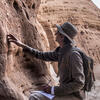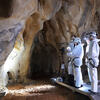You are here
Meet Arthur, the first deep-sea robot archaeologist

In 2014, you embarked on a collaboration with the French government’s DRASSM department of underwater archaeological research)1, which was hoping to launch a programme to develop underwater archaeology robots. What did this involve?
Vincent Creuze2: The idea was to develop, in less than ten years, systems capable of carrying out archaeological excavations at depths exceeding 2000 metres. In 2012, France had acquired a new vessel, the André-Malraux, a 36-metre ship specially designed for underwater archaeology and already equipped with lifting systems and a laboratory. The first stage, in 2013, was to evaluate existing systems, namely the industrial ROVs used in offshore operations.
The DRASSM soon realised that these machines weren't suitable for underwater archaeology as they frequently damaged the objects they collected, and came to the conclusion that they needed to develop their own robotic systems. They then launched a programme to test a range of equipment and robots designed at the Laboratory of Computer Science, Robotics and Microelectronics of Montpellier3 (LIRMM), at a depth of 100 metres.
What were the specific features of the first robots?
V. C.: The first ROV, Speedy, like its twin, Leonard, was designed to carry a grip claw system to pick up objects. We then developed Flipper, which was equipped with a suction device that cleared the excavation site by removing sand, so that objects could be recovered without being damaged. At the same time, we worked with the DRASSM to define the specifications for Hilarion, a robot dedicated to photography manufactured by a French SME. We subsequently came up with Basile, which can be used for sampling or for suction and blowing, depending on the mission and accessories used4.

Between 2019 and 2021, the DRASSM built a second 46-metre-long vessel, the Alfred-Merlin, which was initially used in the Mediterranean. Meanwhile, I was asked to design the ROV Arthur, which is autonomous and incorporates all the technologies developed on our earlier robots.
The ROVs devised before then couldn't dive below 500 metres. Arthur, launched in 2022, can reach a depth of 2500 metres. What are its special features?
V. C.: It has a powerful lighting system and takes very-high-definition photos and videos. The cameras, which record and transmit images live to the pilot, are housed in a large-diameter glass sphere. The images can then be used to create 3D models.
After this initial stage, Arthur uses a suction device to remove the sediment, and then deploys its claws to pick up the objects and place them in a sample bin. The control algorithms make the ROV sufficently stable and precise to recover artefacts without damaging them. In this way we were able to collect very small ones such as a piece of jewellery the size of a coffee bean, as well as other larger items such as a Roman bronze basin weighing 5 kg, without any harm coming to them. Once the work is complete, the robot brings all the objects collected up to the surface.
On board the boat, the control system enables the archaeologists to operate the robots on their own without the help of a professional pilot, which makes for faster reaction times. Regardless of the type of device used and the depth, we work in the same conditions of comfort. What's more, the control room can simultaneously accommodate up to four teams operating different ROVs.
How did you deal with the challenges of operating at great depths?
V. C.: There are of course issues related to pressure, which can be as high as 250 kg/cm². So we designed oil-filled systems for the motors, sampling systems and actuators in order to compensate for external pressure.
However, the ROV would be unable to tow its umbilical cable to these depths on its own. That's why we have a 700 kg large cage suspended beneath the boat by a 2.6 km-long steel cable that provides the power supply and transmits data via fibre optics. Once the cage, which also contains electronic boxes for data conversion, is near the seabed, an internal winch unwinds a 50-metre-long flexible cable connected to the robot, which can thus move around freely.

Once the mission is over, the ROV returns to the cage, which is then hoisted back up to the surface, an operation that takes over 40 minutes from a depth of 2500 m. In the Mediterranean, the weather can worsen very quickly, so we have to keep an eye on the forecast in order to bring the cage safely back up on deck if necessary. Even though we have developed a system for securing it above the water to prevent it from banging into the hull, the slightest mishap could damage the equipment.
Arthur was designed to be easy to repair, which proved to be a major asset during its first dive in the Strait of Sicily in 2022. What do you remember in particular about that mission?
V. C.: For a whole week we were some twenty hours away from the nearest port. One day, Arthur suffered a malfunction. However, since we had all the necessary resources and skills, we were able to fix it overnight. It was an international mission under the aegis of UNESCO involving scientists from seven countries, and was probably the most memorable one I have ever taken part in. We were investigating ancient wrecks lying at a depth of 900 metres. One of them contained columns intended for the construction of a temple. It was spectacular. What's more, there was no light pollution. At night, we could see countless stars and shooting stars. Every evening, dolphins and whales would swim around the boat. It was a wonderful experience.
On every mission, marine biologists work alongside archaeologists. In what ways do Arthur's specifications enhance our understanding of the deep-sea environment?
V. C.: In the images taken by the ROV, you can see animals and plants. I remember the wreck of the Francesco Crispi, an Italian cruise ship sunk during the Second World War, lying on the seabed 500 metres down. It was covered with remarkable clumps of white coral. Photogrammetry of the ship enabled the biologists to collect data and make a 3D model of the coral, in particular to study its growth rate.

Having biologists on board also helps us determine what we can or cannot collect, since archaeological remains can harbour rare biological organisms. In other cases, we sometimes recover objects covered with concretions containing micro-crustaceans or small pieces of sponge. The biologists can then take DNA samples.
How can investigating wrecks and the deep seabed shed light on the fragility of such ecosystems?
V. C.: Wrecks are hotbeds of life. They act as refuges for a wide range of species. They also create unique ecosystems with specific ocean current and chemical parameters, caused by various factors such as the dissolution of metallic elements from the hull. Unfortunately, we also see the impact of deep-sea fishing. Trawl nets are sometimes used at depths exceeding 1000 metres. The metal frames surrounding them can destroy a wreck if they are pulled across it. Sometimes the net can completely blanket a sunken ship and remain in place, pointlessly continuing to catch fish for decades while blocking any access to ROVs.

Mapping wrecks enables the authorites to protect the most outstanding ones by setting up exclusion zones. When ROVs carry out dives, biologists can also measure temperatures and the amount of dissolved oxygen in deep water, thus contributing to the study of the impact of climate change on ecosystems. ♦
- 1. Created in 1966 by André Malraux, France’s Minister of Culture at the time, the DRASSM is responsible for managing the underwater archaeological heritage in the French maritime domain, which covers an area exceeding 11 million square kilometres.
- 2. University professor and head of the Underwater Robotics team at the Laboratory of Computer Science, Robotics and Microelectronics of Montpellier (LIRMM).
- 3. CNRS / Université de Montpellier.
- 4. The ROV “Basile” is still used today for missions above a depth of 150 metres in the Channel and the Atlantic.
Explore more
Author
Specializing in themes related to religions, spirituality and history, Matthieu Sricot works with various media, including Le Monde des Religions, La Vie, Sciences Humaines and even Inrees.


















